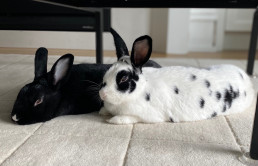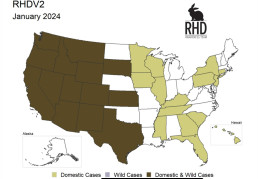Outdoor Play Hazards
HRS Chicago does not recommend outside playtime for domestic rabbits in the US. We have seen far too many injuries and “rare” parasites in our rescued rabbits to comfortably give it the OK. Some of the hazards include :
Outdoor Hazards: Hawks and Crows
The increasing presence of hawks in our area poses a serious threat. In just a matter of seconds, these birds can swoop down and capture a rabbit, even within the confines of a yard or on a deck. It’s important to recognize that open-top pens don’t offer foolproof protection against attacks from birds of prey, dogs, or cats.
Harness and Leash Dangers
Never ever put a harness or leash on a rabbit. Rabbit skeletons are really fragile, they make up only 8% of their body weight, as opposed to 13% in cats. Their skeletons are often referred to as “bird-like.” One swift move from a rabbit in a harness on a leash and their spine can easily snap.
Poisonous Plants
Backyards and gardens are often filled with seemingly harmless yet poisonous weeds and plants. Unfortunately, our domestic companion rabbits lack the instinct to avoid these potentially harmful plants, putting them at risk of ingestion and subsequent health issues.
Chemical Exposure from Lawns
Chemicals commonly used on lawns, such as fertilizers, herbicides, and insecticides, can pose a significant threat to rabbits. As they groom themselves, rabbits may inadvertently ingest these chemicals, resulting in severe illness or death.
Pests and Diseases
The outdoor environment introduces the risk of pests and diseases. Fleas, mites, myiasis, cuterebra(bot fly larva), tapeworm, sarcocystis, toxoplasma, and baylisascaris are all commonly seen in rabbits that have spent time outdoors in our area.
RHDV2 Virus
The highly contagious and lethal RHDV2 virus is in Chicago. It can be transmitted through contaminated grass, soil, insects and more. It’s strongly advised to have your rabbits vaccinated and keep them indoors to minimize exposure.
Indoor Play Areas
Given the multitude of outdoor risks, creating indoor play areas for your rabbit is the safest option. Whether using spare bedrooms, basements, or corners of family rooms, you can design a bunny playground with various stimulating elements, ensuring a secure and enjoyable space for your rabbit to exercise, play, hop, leap, and dance without the associated outdoor dangers.
GI Stasis
GI stasis, or ileus, is a condition in which the rabbit’s gastrointestinal system becomes sluggish or stops moving altogether. It can result from various factors, including poor diet, dehydration, stress, dental disease, or other painful underlying medical problems. The signs of stasis may include reduced or absent fecal output, decreased appetite, lethargy, and a hunched posture. True stasis is always a symptom of a more serious condition as opposed to a disease itself.
Here are steps to address a rabbit in stasis:
- Seek Veterinary Care: If you suspect your rabbit is suffering from stasis, consult a veterinarian experienced in treating rabbits. Prompt medical attention is essential to determine the underlying cause and initiate treatment.
- Hydration: Dehydration is a common cause for low/no appetite. Encourage your rabbit to drink water by providing clean, fresh water in a bowl, never a bottle. A veterinarian may also administer subcutaneous fluids to hydrate the rabbit.
- Proper Nutrition: Maintain a proper diet rich in fiber to stimulate the digestive system. Offer fresh hay and remove high-carbohydrate foods such as carrots, pumpkin and fruit from the diet.
- Pain Management: If your rabbit is in pain, your veterinarian may prescribe medication to alleviate discomfort.
- Gentle Movement and Exercise: Encourage your rabbit to move around to help stimulate their gut and break up any gas bubbles that may be trapped in the GI tract.
- Medication: In some cases, your vet may prescribe medications to stimulate gastrointestinal activity.
- Address the Underlying Cause: Stasis is a symptom of an underlying issue, such as dental disease, infection, liver lobe torsion, heart disease, E. Cuniculi, etc. Identify and address the root cause to prevent recurrence. Always request bloodwork and radiographs from your vet to get a proper diagnosis and to rule out obstruction.
- Prevention: To prevent future stasis episodes, provide a proper diet, maintain dental health, and create a stress-free environment for your rabbit.
What we don’t recommend :
- Force feeding critical care before a vet has ruled out obstruction with x-rays. This can cause more harm to your rabbit.
- Laxatone. The ingredients in laxatone do nothing beneficial for rabbit gut motility. Additionally, if there is dehydrated hair in the GI tract, feeding laxatone can coat the hair and inhibit hydration of the mass, making it less likely to move along through the GI tract. The main ingredient in Laxatone is petrolatum, which is a byproduct of gasoline and banned in the EU.
- Papaya and pineapple. The enzymes in these fruits can actually irritate the lining of the stomach of a rabbit who isn’t eating, again causing more harm than good. Fruit or any other high sugar food can be detrimental to a rabbit in stasis.
- Simethicone(baby gas drops.) The latest understanding amongst the most rabbit savvy vets is that simethicone does nothing beneficial for the type of gas rabbits produce. Encouraging your rabbit to move around will help break up any gas bubbles more efficiently.
- Abdominal massage. It’s possible to bruise internal organs while massaging the abdomen. Again, encouraging the bunny to move around will have the desired effect.
Stasis is a serious condition that requires immediate attention. Knowing the symptoms and acting promptly by consulting a rabbit-savvy veterinarian is vital. By following the prescribed treatment plan and maintaining a proactive approach to your rabbit’s health, you can help ensure a happy and healthy life for your beloved companion.
Source – https://www.ncbi.nlm.nih.gov/pmc/articles/PMC7258705/
RHDV-2: Prevention & Treatment
Rabbit Hemorrhagic Disease Virus 2 (RHDV-2) is a highly contagious and deadly viral infection that affects domestic and wild rabbits. First identified in France in 2010, RHDV-2 has rapidly spread across the world, posing a significant threat to rabbit populations.
RHDV-2 Transmission and Symptoms
RHDV-2 is transmitted through direct contact with infected rabbits, as well as indirect transmission via contaminated food, water, insects or other contaminated objects. In some outbreak areas, it appears to spread along highways, so it’s believed to be moved around on car tires as well. You can also bring it into the home on your clothes and shoes. The virus can survive for extended periods at extreme temps outside the host, making it extremely hardy and easily transmissible. Once inside a rabbit’s body, RHDV-2 attacks the liver and causes internal bleeding, leading to a sudden and often fatal disease course. The typical symptoms of RHDV-2 often resemble classic stasis and include lethargy, anorexia(low or no appetite), fever, respiratory distress, and in some cases, neurological signs. Sometimes the only symptom is sudden, unexpected death. Affected rabbits may die within 12 to 36 hours of showing symptoms. It’s important to have your vet do a necropsy on any rabbit who dies unexpectedly so that there is an accurate representation of disease prevalence in our area.
Prevention of RHDV-2
ALL rabbits are at risk of infection, even if they never go outdoors. Preventing RHDV-2 is essential to safeguard rabbit populations, especially in regions where the virus is prevalent. Several key preventive measures can be implemented:
- Vaccination: Vaccination is the most effective means of preventing RHDV-2. Medgene’s safe and effective vaccine has been widely available since October 2021. Rabbit guardians should consult with their veterinarians to determine the most suitable vaccination schedule for their rabbits.
- Biosecurity: Maintaining strict biosecurity measures is crucial in preventing RHDV-2. Isolating new rabbits, keeping shoes outside, washing hands and changing clothing when handling new rabbits, regularly cleaning and disinfecting enclosures, and preventing contact with wild rabbits are key components of biosecurity.
- Quarantine: Quarantine newly acquired rabbits for a minimum of 21 days to ensure they are not carriers of the virus.
- Limiting Contact: Minimize contact between domestic and wild rabbits, as well as rabbits from different households.
- Monitoring: Keep a close eye on the health of your rabbits and be vigilant for any signs of illness. Early detection can be crucial in containing the spread of the virus.
Treatment of RHDV-2
Unfortunately, there is no specific treatment for RHDV-2. Once a rabbit shows symptoms, the disease typically progresses rapidly, and the mortality rate is extremely high, up to 90%. The focus should primarily be on prevention. Euthanasia is often recommended for affected rabbits to prevent further suffering and to limit the spread of the virus.
Management and Control
Managing RHDV-2 outbreaks is challenging, but there are strategies that can be employed to minimize its impact:
- Disinfection: Thoroughly disinfect cages, equipment, and any area where rabbits were housed or moved. Use appropriate disinfectants to kill the virus effectively. We recommend Rescue brand disinfectant or bleach.
- Containment: Isolate affected rabbits to prevent contact with healthy ones.
- Quarantine: Quarantine newly introduced rabbits and those returning from shows or other events to ensure they are not carriers of the virus.
- Public Awareness: Educate rabbit owners about the virus, its transmission, and the importance of vaccination and biosecurity measures.



